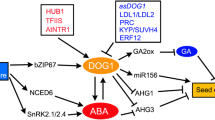Abstract
Displacement transducers were used to demonstrate that localised wounding causes a rapid and systemic increase in leaf thickness in seedlings of wheat (Triticum durum Desf. cv. Iva). These increases are interpreted as reflecting wound-induced hydraulic signals. The duration of the wound-induced increase was found to be about 1 h or more, and it was shown that repeated wounds could induce repeated responses. The increase occurred even when plants had no access to an external water supply. Change in leaf thickness was shown closely to reflect change in leaf water potential. The velocity and kinetics of the wound-induced hydraulic signal were measured using multiple transducers ranged along a single leaf. The front of the signal was shown to travel through the plant at rates of at least 10 cm · s−1. Development of the increase in leaf thickness was found to be relatively faster furthest from the wound. Onset of the change in leaf thickness in leaves remote from the wound was shown to precede onset of changes in surface electrical potential (variation potential) which are also induced by wounding. In contrast to reports from other species, variation potentials in wheat were here shown to spread extremely rapidly, at rates similar to that of the hydraulic signal. These data support the view that wound-induced hydraulic signals are the trigger for variation potentials in wheat.
Similar content being viewed by others
Abbreviations
- Ψw :
-
water potential
References
Bowles, D.J. (1990) Defense-related proteins in higher plants. Annu. Rev. Biochem. 59, 873–907
Chessin, M., Zipf, A.E. (1990) Alarm systems in higher plants. Bot. Rev. 56, 193–235
Cosgrove, D.J., Durachko, D.M. (1986) Automated pressure probe for measurement of water transport properties of higher plant cells. Rev. Sci. Instrum. 57, 2614–2619
Frachisse, J.-M., Desbiez, M.-O. (1989) Investigation of the wave of electric depolarization induced by wounding in Bidens pilosus L. Biochem. Physiol. Pflanzen. 185, 357–368
Haberlandt, G. (1890) Das reizleitende Gewebesystem der Sinnpflanze. Leipzig
Hüsken, D., Steudle, E., Zimmermann, U. (1978) Pressure probe technique for measuring water relations of cells in higher plants. Plant Physiol. 61, 158–163
MacDougal, D.T. (1896) The mechanism of movement and transmission of impulses in Mimosa and other “sensitive” plants: a review with some additional experiments. Bot Gaz. XXII, 296–303
Malone, M., Stanković, B. (1991) Surface potentials and hydraulic signals in wheat leaves following localised wounding by heat. Plant Cell Environ. 14, 431–436
Matsuda K., Rayan, A. (1990) Anatomy: a key factor regulating plant tissue response to water stress. In: Environmental injury to plants, pp. 63–88, Academic Press, London
Meidner, H. (1990) The absorption lag, epidermal turgor and stomata. J. Exp. Bot. 41, 1115–1118
Nakahori, K., Koizumi, K., Muramatsu, S., Ohtani, H., Masuko, M., Nakase, S., Katou, K., Okamoto, H. (1990) Measurement of the respiration dependent component of intracellular pressure with an improved pressure probe. Plant Cell Physiol. 31, 859–864
Pickard, B.G. (1973) Action potentials in higher plants. Bot. Rev. 39, 172–201
Raschke, K. (1970) Leaf hydraulic system: rapid epidermal and stomatal responses to changes in water supply. Science 167, 189–191
Ricca, U. (1916) Soluzione d'un problema di fisiologia. La propagazione di stimulo nella Mimosa. Nuovo Giorn. Bot. Ital. 23, 51–170
Roblin, G. (1979) Mimosa pudica: a model for the study of the excitability in plants. Biol. Rev. 54, 135–153
Roblin, G. (1985) Analysis of the variation potential induced by wounding in plants. Plant Cell Physiol. 26, 455–467
Ryan, C.A., An, G. (1988) Molecular biology of wound-inducible proteinase inhibitors in plants. Plant Cell Environ. 11, 345–349
Schildknecht, H. (1984) Turgorins- new chemical messengers for plant behaviour. Endeavor 8, 113–117
Sibaoka, T. (1969) Physiology of rapid movements in higher plants. Annu. Rev. Plant Physiol. 210, 165–184
Tinz-Füchtmeier, A., Gradmann, D. (1990) Laser-interferometric re-examination of rapid conductance of excitation in Mimosa pudica. J. Exp. Bot. 41, 15–19
Van Sambeek, J.W., Pickard, B.G. (1976) Mediation of rapid electrical, metabolic, transpirational, and photosynthetic changes by factore released from wounds. I. Variation potential and putative action potentials in intact plants. Can. J. Bot. 54, 2642–2650
Wildon, C., Doherty, H.M., Eagles, G., Bowles, D.J., Thain, J.F. (1989) Systemic responses arising from localized heat stimuli in tomato plants. Ann. Bot. 64, 691–695
Zhang, J., Davies, W.J. (1991) Root signals and the regulation of growth and development of plants in drying soil. Annu. Rev. Plant Physiol. Mol. Biol. 42, 55–76
Zimmermann, U., Steudle, E. (1978) Physical aspects of water relations of plant cells. Adv. Bot. Res. 6, 45–117
Author information
Authors and Affiliations
Additional information
Grateful thanks are due to Paul Springer of the HRI (Wellesbourne) mechanical workshop for building equipment, and to H.G. Jones for helpful discussion.
Rights and permissions
About this article
Cite this article
Malone, M. Kinetics of wound-induced hydraulic signals and variation potentials in wheat seedlings. Planta 187, 505–510 (1992). https://doi.org/10.1007/BF00199969
Received:
Accepted:
Issue Date:
DOI: https://doi.org/10.1007/BF00199969




